Content
Published:
This is an archived release.
Fewer crimes, especially thefts
In 2014, 372 000 offences were reported to the police, which was 4.2 per cent less than the year before. There was a 6.1 per cent drop in the number of crimes, and the drop in thefts had the most significant impact on the total decrease in offences reported to the police.
| 2014 | Change in per cent | ||||
|---|---|---|---|---|---|
| 2013 - 2014 | 2009 - 2014 | 2004 - 2014 | 1999 - 2014 | ||
| Offences reported | 372 107 | -4.2 | -6.4 | -8.7 | -8.6 |
| Offences reported per 1 000 population | 72.8 | -5.3 | -12.1 | -18.2 | -20.5 |
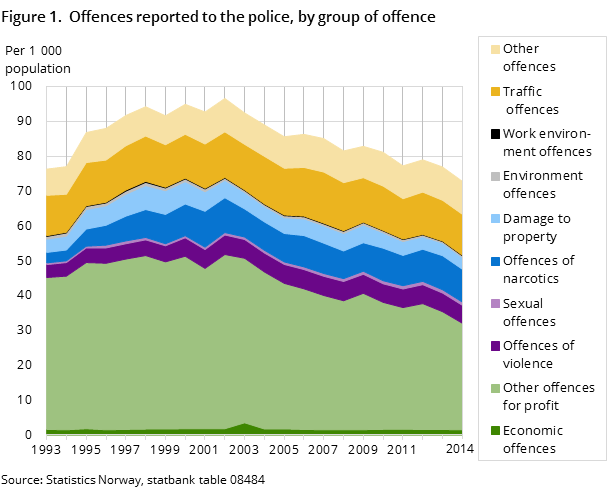
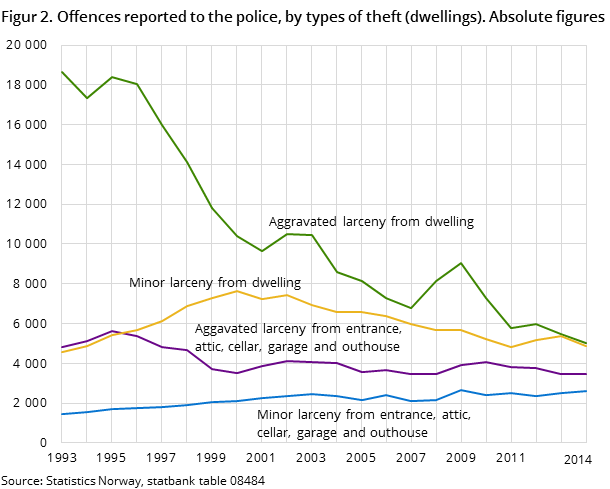
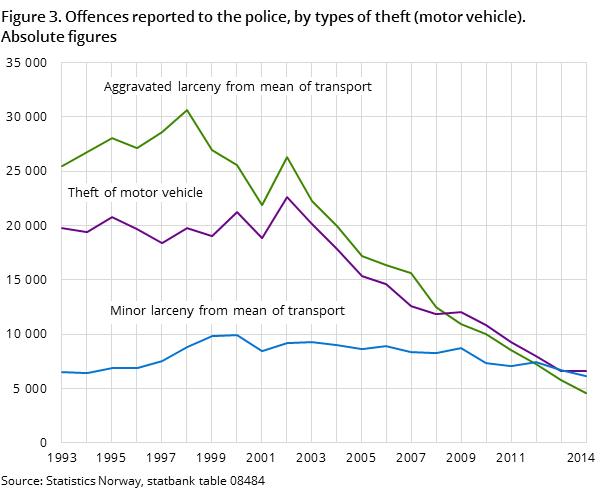
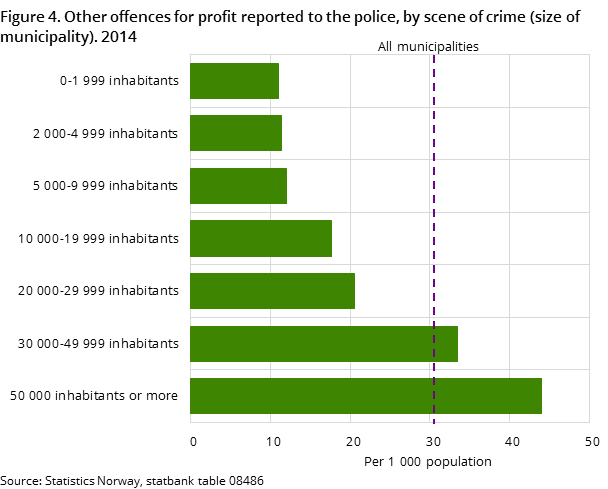
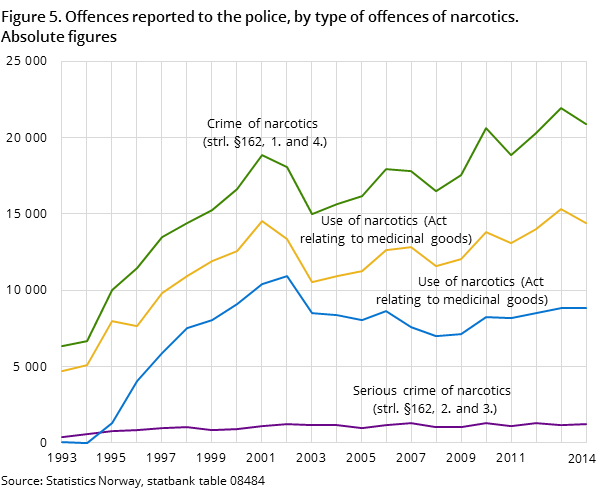
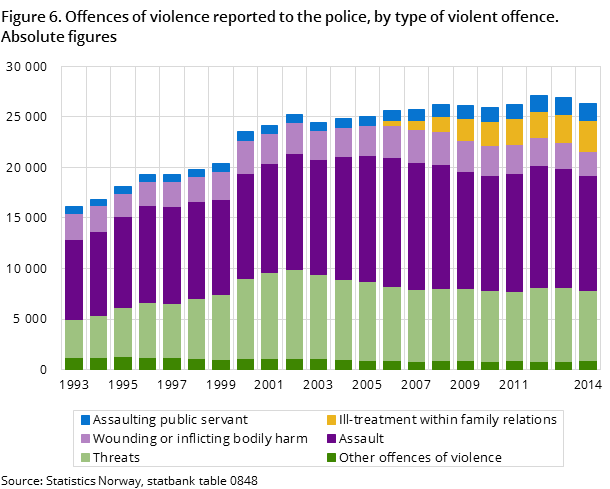
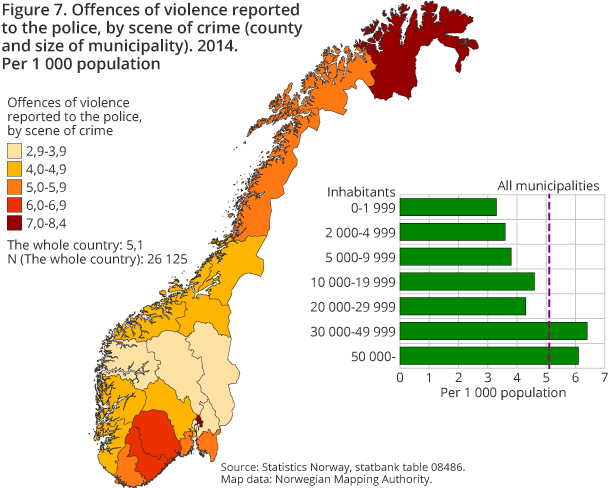
The police and prosecuting authority registered 253 000 crimes and 119 000 misdemeanours in 2014. This is 16 400 fewer crimes than the year before, while the number of misdemeanours remains the same. Adjusting for the increase in population during this period, the 2014 level is lower than in all preceding years (in Norwegian) of corresponding statistics (1993-2013).
Reduction for several groups of offences, but most for offences for profit
The 156 200 offences for profit reported to the police is 14 700 fewer than the previous year, which is a drop of 8.6 per cent. In 2014, 48 100 narcotics offences were reported to the police; 1 300 fewer than in 2013. There was also a drop in the number of reported incidents of damage to property, offences of violence and economic offences.
The scale of thefts and other types of offences for profit is now lower than in all preceding years of corresponding statistics. Offences for profit made up 42 per cent of all offences reported to the police in 2014, which is a significantly smaller proportion than in any previous years.
Decrease for most types of offences for profit
A total of 76 700 simple larcenies and 36 200 aggravated larcenies were reported in 2014. This is a drop of 6 and more than 19 per cent since 2013 respectively. In absolute numbers, the drop was also significantly greater for aggravated larcenies, with nearly 8 800 fewer than in the previous year. Thus, the total number of reported incidents of aggravated larcenies is lower in 2014 than in all previous years of corresponding statistics.
Compared to the previous year, 2014 saw a decrease in the number of registered robberies, receiving stolen goods, subsequent assistance to the offender and misdemeanours against the Duty Act.
Greatest decrease in aggravated larcenies from persons in a public place
The more than 16 600 incidents of aggravated larcenies from persons in a public place is nearly 5 900, or 26 per cent, fewer than in 2013. This corresponds to two thirds of the decrease in the total number of aggravated larcenies during the last year and 40 per cent of the total decrease for all offences for profit.
As in previous years, the number of reported incidents of aggravated larcenies from persons in a public place is greatest in Oslo. Oslo is, however, the county with the greatest decrease from 2013 to 2014. The nearly 10 000 reported incidents of aggravated larcenies from persons in a public place in the capital is a whole 32 per cent fewer than in 2013, and this contributed to the further drop in the large decrease from the previous year. There was also a significant decrease for the rest of the country in 2014, with 16 per cent fewer reported incidents of aggravated larcenies than in 2013. Furthermore, 3 000 incidents of aggravated larcenies from persons in a public place were reported with a scene of crime outside of Norway. This is 12 per cent less than the previous year.
Also significant decrease for other types of thefts
A total of 17 300 thefts from cars and other motor vehicles were reported, which is 9 per cent fewer than in the previous year. As illustrated in figure 3, this downward trend began in the early 2000s, and this type of theft has more than halved over the past seven years. Additionally, a total of 16 000 thefts from dwellings and holiday homes were reported to the police in 2014; a reduction of 5 per cent from the year before – and the level of this type of theft is now lower than in all previous years of statistics on offences reported to the police. There was also a decrease for the category minor larcenies from restaurants, where the nearly 4 600 reported incidents represents a drop of 26 per cent from the previous year.
More thefts of bicycles and minor larcenies from shops
The 18 300 thefts of pedal cycles reported in 2014 is an 11 per cent increase from 2013. This is the highest number of reported pedal cycle thefts since the beginning of the 2000s. About two thirds of these thefts are reported to the police via the Internet. The possibility of reporting this kind of theft online since autumn 2009 may have contributed to the relatively high level of offences in recent years.
Somewhat more incidents of petty larceny and minor larcenies from shops were also reported. The 18 800 reported incidents is 3 per cent more than in 2013.
Most offences for profit in highly populated municipalities
By scene of crime, with 38 700 thefts and other offences for profit, Oslo was the county with the highest number of these kinds of offences in 2014. Also when adjusting for the population density, Oslo is the county with by far the most reported offences for profit, with 61.0 per 1 000 population. Despite seeing a drop in these offences last year, the level in Oslo is almost double that of the counties with the second highest level of offences for profit; Vest-Agder and Telemark, with 32.3 and 31.8 per 1 000 population respectively. Sogn og Fjordane had the lowest number and by far the lowest level, with 7.8 reported offences for profit per 1 000 population.
Generally, the volume of reported offences for profit will increase with the number of residents in a municipality, as illustrated in figure 4. While there were 11.0 offences for profit per 1 000 population in municipalities with less than 2 000 inhabitants, the corresponding figure is 44.0 for municipalities with 50 000 inhabitants or more. A geographical breakdown of offences for profit shows that the volume of offences for profit also corresponds to the municipalities’ centrality. For example, there were 10.8 offences for profit per 1 000 population in the least central municipalities, while the corresponding figure for the most central municipalities was 33.9.
Fewer, but still a high number of narcotics offences
A total of 48 100 narcotics offences were registered in 2014. This is nearly 3 per cent fewer than in 2013, which was a year with a high level of registered narcotics offences. A total of 23 400 violations under the Penal Code were registered and 24 700 violations under the Act relating to medicinal products. Both of these figures represent a drop of almost 3 per cent from 2013.
A total of 14 400 incidents of narcotics use were registered, which is regulated by the Act relating to medicinal products. This is 6 per cent fewer than in 2013. The 8 850 violations of possession of small quantities of illegal narcotics is, however, at the same level as the previous year.
Adjusted for population size, the Agder counties had the greatest level of reported narcotics offences, with more than 12 reported narcotics offences per 1 000 population. The level is, however, almost as high in the other counties in the south ¬– where Oslo, Telemark, Vestfold and Rogaland had between 11.7 and 10.7 narcotics offences per 1 000 population in 2014.
Fewer reported offences of violence
Among the total 26 300 offences of violence in 2014, nearly 7 000 where threats and 18 300 were incidents of physical violence. For both groupings of offences of violence, the number is somewhat lower than in 2013. The number of registered offences of violence was 2.4 per cent lower in 2014 than the year before. When adjusting for population density, the volume of reported offences of violence is lower than the relatively stable level over the preceding 14 years.
Decrease for different types of violence…
A total of 11 300 assaults were registered in 2014, which is more than 3 per cent fewer than in 2013. In addition, 2 371 incidents of wounding or inflicting bodily harm were registered, which is a more serious type of violent offence. This is 7 per cent fewer than in the previous year.
…and increase for ill-treatment within family relations
A total of 3 056 incidents of ill-treatment within family relations were reported in 2014. This is 8 per cent more than in 2013 and is higher than in any of the previous years. This increase is on the back of legislation introduced in 2006 on ill-treatment within family relations.
Both for the total number of offences of violence and for the more specific types of violence, we saw a similar development from 2012 to 2013 – as illustrated in figure 6. During the past three-year period, the changes are significantly greater, and compared to the figures in 2012, there is for instance more than 14 per cent fewer incidents of wounding or inflicting bodily harm and nearly 20 per cent more registered incidents of ill-treatment within family relations.
Highest levels of violence in Finnmark and Oslo
As in all previous years, Finnmark and Oslo are the counties with the highest level of reported offences of violence, with 8.4 and 7.6 offences of violence per 1 000 population respectively. As in previous years, Sogn og Fjordane had the lowest level, with 2.9 offences of violence per 1 000 population, as shown in figure 7.
Most damage to property in Oslo
Nearly 17 500 incidents of damage to property were reported in 2014, which is 4.5 per cent fewer than in 2013 and as much as 29 per cent fewer than in 2009. Oslo is the county with the highest level of damage to property, with 8.4 reported incidents of damage to property per 1 000 population in 2014. Of all reported damage to property, 30 per cent of incidents were committed in Oslo.
4 780 sexual offences reported in 2014
In total, the number of sexual offences reported is about the same as in the previous year. Among the reported sexual crimes in 2014, there were 1 127 rapes, 85 attempted rapes, 812 incidents of sexual intercourse with a child and 486 incidents of a sexual act with a child under 16 years of age. A total of 941 incidents of sexual violation or other indecent behaviour were also reported.
60 000 reported traffic offences
In 2014, nearly 2 per cent more traffic misdemeanours were reported than in 2013. These included almost 13 400 reported incidents of road users without a driving licence, 12 900 reported incidents of speeding and 9 100 incidents of driving under the influence of alcohol. More offences were reported for all of these types of crimes in 2014 than in 2013.
Late registrations of offences reported to the police, time break between 2011 and 2012Open and readClose
Due to a type of re-registration, some actual reported offences will not be included in the data basis for the statistics on offences reported to the police (or Victims of offences reported to the police). In each of the years 2012-2014, there are about 1 200 offences, of which 1 000 are crimes, that are excluded from the statistics. The scope of these re-registrations was vastly greater in 2011 and earlier years: on average in the period 2008-2011 there were about 7 000 offences (4 800 crimes) annually, which for this reason were excluded from the statistics. For more information, see About the statistics, chapter on “Sources of error”.
Relocate and change of the Penal code on Return to the country after expulsionOpen and readClose
The Immigration Act of Return for Expulsion (§ 108, paragraph 3) entered into force on 15 January 2014 and replaced the corresponding provision in the Penal Code (§ 342, paragraph 1). This entails a redistribution of statistics that use Statistics Norway’s standards Category of offences and Type of offence. Returning after expulsion was previously categorised as Misdemeanour in the offence type Other, offense against the Criminal Code. After these changes, it is categorised as Crime in the offence type Crime against other Acts. In the statistics on offences reported to the police, this redistribution led to about 400 more crimes in 2014. This amendment does not involve a redistribution in the standard Group of offence.
Contact
-
Reid Jone Stene
E-mail: reid.jone.stene@ssb.no
tel.: (+47) 99 02 22 01
-
Siri Fjærtoft Fossanger
E-mail: siri.fossanger@ssb.no
tel.: (+47) 99 72 49 27
